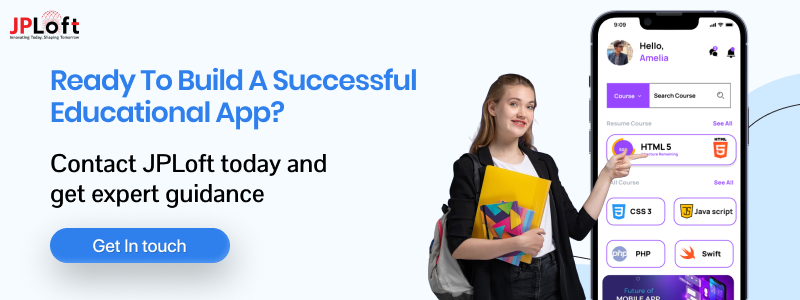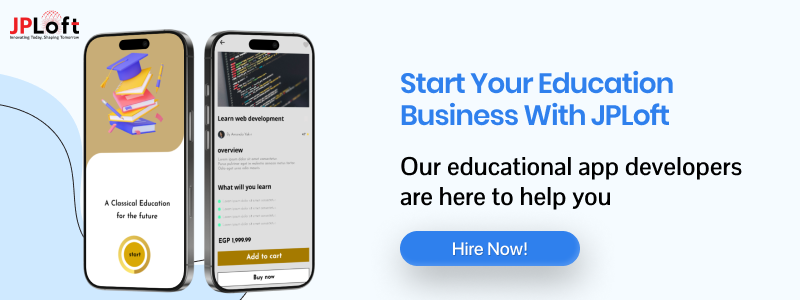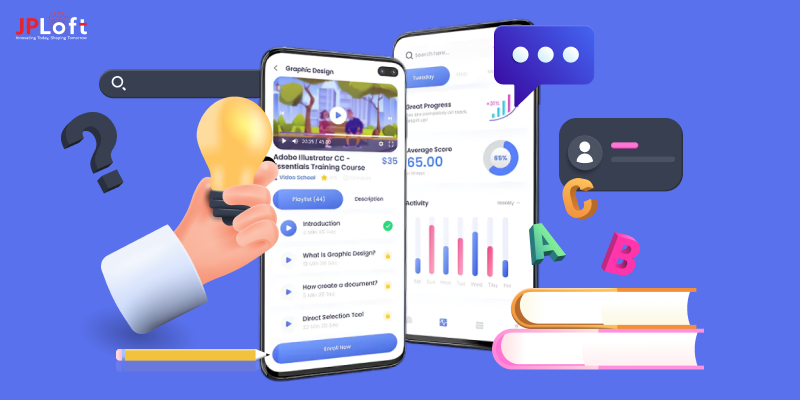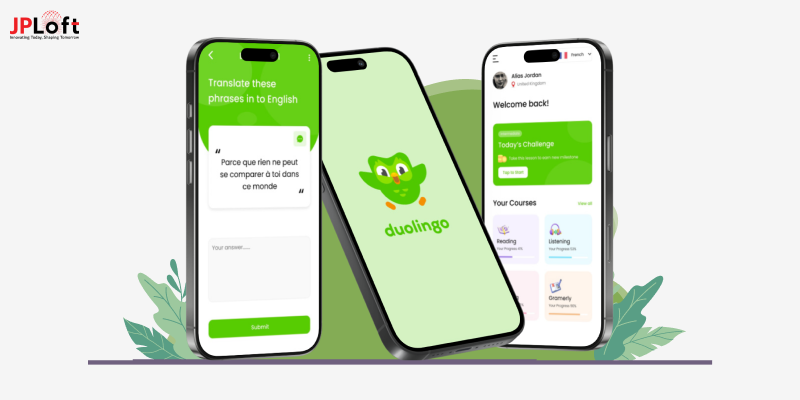When it comes to making a great educational app, choosing the right business model is important. An educational app business model decides how your app will create revenue while giving worth to users. In this blog, we will explore different monetization models and revenue models used in the edtech industry, helping you find the best way for your educational app's success. Whether it's premium, subscription, or pay-per-course, each model plays a vital role in shaping your app's growth and survival.
Understanding Education Business Models and Its Importance
Understanding the right educational business model is key to the success of any educational app. The business model decides how the app will produce revenue while giving value to its users. It helps define the long-term sustainability of the app by setting up price strategies, content delivery methods, and monetization choices.
Choosing the right model ensures you can meet both educational goals and business goals successfully.
With several educational app business models available, such as subscription-based, freemium, or pay-per-course, it's important to match your model with your target audience’s wants and desires.
By doing so, you create an education app that offers a seamless experience that draws users and keeps them involved, all while ensuring steady revenue growth. Understanding these educational business models and revenue models is important for building a profitable and effective app.
Top Educational App Business Models
Here is the list of top educational models adopted by industry giants, streamlining their revenue generation:
1. Subscription-Based Model
The subscription-based model allows users to access the app's full range of features and educational content by paying a recurring fee, typically monthly or annually. This model works well for apps offering continuous learning experiences, such as language courses, skill-building, or test preparation. Subscribers benefit from premium features like ad-free experiences, offline access, and personalized learning paths.
Examples:
-
Duolingo Plus: Offers offline lessons and an ad-free experience for language learners.
-
Coursera: Grants unlimited access to a wide variety of courses for a monthly subscription fee.
Pros and Cons:
|
Pros |
Cons |
|
Predictable, steady revenue stream |
Users may cancel during financial strain |
|
Encourages consistent learning behavior |
Requires constant content updates |
|
High customer retention if value is maintained |
High competition in subscription-based markets |
2. Freemium Model
The freemium model allows users to access basic content for free, with premium content or advanced features available through a paid upgrade. This approach attracts a large user base, converting some to paid subscriptions over time.
Examples:
-
Khan Academy: Free educational resources with optional donations.
-
Quizlet: Offers free flashcards with premium options for ad removal and advanced study tools.
Pros and Cons:
|
Pros |
Cons |
|
Attracts a large, diverse audience |
Low conversion rate to paid users |
|
Builds strong brand awareness |
High costs for maintaining free services |
|
Effective for market penetration |
Monetization depends on upselling |
3. Pay-Per-Course Model
In the pay-per-course model, users are charged individually for each course they enroll in. This monetisation model works well for users who prefer to pay only for the courses they need rather than committing to a subscription.
Examples:
-
Udemy: Users purchase individual courses tailored to their interests or needs.
-
LinkedIn Learning: Provides career-specific courses for a one-time fee.
Pros and Cons:
|
Pros |
Cons |
|
High revenue per user |
Continuous user acquisition is needed |
|
Ideal for niche or professional courses |
Limited engagement after course completion |
|
Simplifies pricing for users |
Repeat purchases are uncertain |
4. Advertisement-Based Model
Educational apps using the advertisement-based model generate revenue by displaying ads within the app. This model offers free access to users while monetizing through ads, which can be banner ads, interactive ads, or video ads.
Examples:
-
Duolingo: Runs ads in the free version to sustain operations.
-
Brainscape: Displays advertisements to support its free flashcard platform.
Pros and Cons:
|
Pros |
Cons |
|
Keeps the app free for users |
Ads may disrupt the user experience |
|
Monetizes non-paying users |
High dependency on ad revenue |
|
Scales with increased app usage |
It requires a large user base to be profitable |
5. In-App Purchases
With in-app purchases, educational apps provide free basic functionality and charge users for additional features, resources, or content within the app. This revenue model gives flexibility to users while allowing developers to generate money from premium offerings.
Examples:
-
Memrise: Offers add-ons for more advanced learning techniques.
-
Prodigy Math: Sells in-app tools to help users progress faster in math challenges.
Pros and Cons:
|
Pros |
Cons |
|
Encourages optional spending |
Revenue can be unpredictable |
|
Keeps the app affordable for new users |
Some users may feel pressured to buy |
|
Adds value without requiring subscriptions |
May lead to dissatisfaction if not balanced |
6. Corporate Training Model
In the corporate training model, educational apps partner with businesses to provide training content to employees. This model often involves bulk licensing agreements and custom content tailored to the company’s needs, allowing companies to train their workforce efficiently.
Examples:
-
Coursera for Business: Offers training resources for companies to improve workforce skills.
-
Skillsoft: Specializes in e-learning solutions for corporate environments.
Pros and Cons:
|
Pros |
Cons |
|
High-value contracts |
Limited audience (corporate only) |
|
Strengthens app's credibility |
Lengthy and complex sales cycles |
|
Bulk user acquisition opportunities |
Customizations can be resource-intensive |
7. Marketplace Model
In the marketplace model, educational apps allow third-party content creators to upload and sell their courses. The platform typically takes a commission from each sale, enabling a vast range of learning materials and subjects.
Examples:
-
Udemy: Instructors can sell their courses independently.
-
Teachable: Enables educators to market and sell their own content.
Pros and Cons:
|
Pros |
Cons |
|
Expands the range of available courses |
Quality control can be challenging |
|
Minimal content creation by platform |
Revenue depends on instructor activity |
|
Scales well with increased participation |
High competition among instructors |
8. Sponsorship Model
Sponsorships in educational apps involve partnering with brands or companies to sponsor specific courses, events, or content sections. This model helps both parties: the brand gets exposure to a targeted audience, and the platform receives funding.
Examples:
-
TED-Ed: Sponsored by corporations to fund educational resources.
-
QuizUp: Partners with brands to create sponsored quizzes.
Pros and Cons:
|
Pros |
Cons |
|
Revenue with minimal impact on users |
Relies on securing regular sponsorships |
|
Adds credibility through reputable sponsors |
May restrict app’s creative freedom |
|
Maintains free access for users |
Sponsorships may not always align with brand values |
9. Partnership Model
The partnership model in educational business models entails forming strategic collaborations with other organizations, such as universities, content creators, or technology companies, to co-develop or co-market educational products and services.
Examples:
-
Pearson: Partners with universities to provide online courses.
-
LinkedIn Learning: Collaborates with software companies to offer certified courses.
Pros and Cons:
|
Pros |
Cons |
|
Access to new audiences and expertise |
Can require significant time and resources |
|
Enhances credibility through partnerships |
Limited independence in decision-making |
|
Shared resources reduce development costs |
Risk of conflicting interests |
10. Licensing Model
In the licensing model, educational app developers grant other businesses or educational institutions the rights to use their content or technology for a fee. This model enables the broad distribution of educational resources while generating substantial revenue.
Examples:
-
Blackboard: Licenses its educational tools to institutions.
-
Kaltura: Provides licensed video solutions for e-learning.
Pros and Cons:
|
Pros |
Cons |
|
High upfront revenue |
High development and maintenance costs |
|
Encourages long-term collaboration |
Requires continuous updates |
|
Minimal effort to scale once established |
Limited creative flexibility for licensees |
How To Choose The Right Educational Business Model
Choosing the right educational business model for your app is a crucial choice that requires a deep understanding of several factors. By aligning these factors with your long-term goals, you can identify the monetisation models that best fit your needs, ensuring a balance between user satisfaction and sustainable app growth.
Keep in mind that your choice may evolve as your app grows, so remain flexible and willing to adapt as your audience and content strategy change.
Here’s a complete approach to help guide your decision-making process:
► Understand Your Audience
It's important to analyze your target audience’s habits and tastes. Are they professionals looking for certifications, students searching for specific classes, or individuals wanting free resources? This understanding will guide you toward selecting the right educational app business model.
For example, students might prefer freemium models with optional paid features, while professionals might lean toward subscription-based models.
► Revenue Goals
Your revenue strategy also determines the right model. If your goal is consistent, recurring revenue, subscription-based models (monthly or yearly) are a good choice.
They provide predictable income over time and help in building a loyal user base. Alternatively, if you want to generate revenue from the demand for specific content, a pay-per-course model will allow you to monetize individual courses or lesson packs.
► Market Demand
Evaluate what models are working best in the current market. Are users shifting towards a freemium model with ads or are they ready to pay ahead for premium content?
Popular monetisation models like advertisement-based or in-app payments can provide significant income, especially if you have a large user base. Additionally, business training or licensing might be helpful if you're targeting organizations or educational institutions.
► Content Type
The nature of your content plays a big part in choosing the business model. If you offer in-depth, structured courses with various learning paths, a subscription-based model or pay-per-course model would likely work better, giving users access to your full content library for a recurring fee or as individual course sales.
On the other hand, if your app is focused on offering quick tutorials or single-topic lessons, a pay-per-course or in-app purchases model may make more sense.
► Scalability
Consider how easily your model can scale. If you plan on expanding your app’s offerings, a marketplace model can allow external instructors to offer courses through your platform, expanding your content library without increasing your workload. Similarly, a licensing model could allow other companies or institutions to use your educational content, thus broadening your reach.
Why is Selecting the Right Educational Business Model Important?
Selecting the right educational app business model is important for the success and longevity of your app. It directly affects your revenue creation, customer engagement, and long-term growth.
By picking an appropriate educational business model, you ensure that your app meets the needs of your target audience while keeping financial stability.
The right Edetech business model also helps in optimizing the cost to build an education app, as it allows you to allocate resources more effectively. For example, a subscription-based model can provide consistent revenue, making it easier to fund ongoing growth and content creation. Meanwhile, a freemium model can grow your user base quickly, giving ample possibilities for monetization through in-app purchases or ads.
By matching your education app features with the right model, you improve the user experience, keep customers, and grow your business efficiently. The ideal educational business model not only supports user happiness but also drives profitability, ensuring long-term sustainability in a competitive market.
Things To Consider While Implementing the Educational App Business Model
When implementing the right Edtech business model, there are several key factors to consider:
♦ Content Quality
High-quality, accurate, and up-to-date material is important for any educational app business model. Users expect accurate information, so making material that is both engaging and educational is key to keeping customers.
Investing in experienced trainers and subject-matter experts to create this material ensures the app’s image stays strong.
♦ Diverse User Needs
Different users come with different levels of knowledge and learning tastes. Some may need beginner-level material, while others seek advanced understanding. Additionally, users prefer different learning styles like visual, verbal, or physical.
Meeting these needs requires a flexible educational business model that offers individual learning paths, adaptive tools, and varied material forms.
♦ User Retention
Retaining users is important for the long-term success of any educational app business model. Users tend to lose interest if the app fails to engage them regularly.
Implementing personalized suggestions, gamification, progress tracking, and continuous content changes can help maintain users by giving a dynamic learning experience that keeps them back.
♦ Monetization
Monetization is a major issue in educational business models. Striking the balance between earning income and offering value to users is tricky. Apps must ensure that their monetization model (like a subscription or in-app payments) does not hinder the user experience.
Careful planning is needed to avoid overwhelming users with paid advertisements or excessive ads while still producing sustainable income.
♦ Technology and Maintenance
With technological developments, the app must change regularly. Ensuring the app runs easily on all devices, including desktops, smartphones, and tablets, needs ongoing upkeep and updates. Bugs, glitches, or slow speed can lead to bad user experiences.
Moreover, as the educational app business model grows, it must adopt new technologies to stay competitive and meet users’ demands.
♦ Legal and Compliance Issues
The Edtech business model must comply with various laws, especially regarding data privacy (like GDPR or COPPA). Ensuring agreement with intellectual property rights and educational standards is also important.
Navigating these legal issues can be time-consuming but is crucial to avoid legal battles or fines.
♦ Cultural Sensitivity
With a global audience, your educational app must be sensitive to different cultures, languages, and educational systems. Customizing the content and style to fit various areas and user tastes can make the app more appealing to a diverse audience.
This customization also goes to handling culture, learning preferences, and educational practices in different countries.
♦ Market Competition
The edtech area is highly competitive, with numerous apps giving similar features. A strong educational business model that clearly outlines your unique value proposition is important for differentiation.
Without proper marketing and company positioning, your app may struggle to stand out in a crowded market.
Why Choose JPLoft for Your Educational App Development?
Our education app development company makes educational apps that are scalable, innovative, and focused on the user that appeal to a wide range of people. We offer complete development services that are tailored to your needs because we know a lot about how to make money with educational apps and the newest technologies.
Our team makes sure that the results are high-quality and in line with your business goals from the time of ideation to launch. We help you stand out in the crowded edtech market by adding cutting-edge features like AI-powered learning and game-based learning. Let JPLoft turn your idea into a successful app.
Wrapping Up
Selecting the right educational app business plan is a critical step in building a successful edtech platform. A well-thought-out model not only helps the business grow, but it also makes users happier and more involved. By handling challenges like user engagement, scaling, and monetization carefully, your app can make a significant impact in the education sector.
Work with professionals to make an app that fits your idea, is easy to use, and meets market needs. This is the start of the future of education.
FAQs
The subscription-based model is one of the most popular choices as it provides consistent revenue and keeps users engaged over time.
Consider your target audience, budget, scalability, and monetization goals to select a suitable educational business model.
The cost varies depending on features, platform, and the chosen educational app business model. Consulting experts like JPLoft can provide accurate estimates.
Yes, many apps successfully integrate models like freemium with in-app purchases or advertisements for better monetization.
A well-structured educational business model ensures users find value, remain engaged, and contribute to the app’s growth.














Share this blog